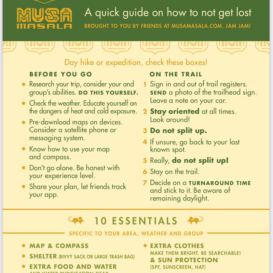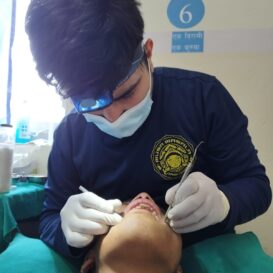Whether you’re climbing, hiking, camping or even trekking in the Himalaya, wilderness travel can be a challenging experience. Add in controlling your blood sugar as a type 1 diabetic as your body adjusts to new foods, environments and stress levels, and you can have your hands full.
We reached out to a special adventurer, Svati Kirsten Narula. Svati is a writer, runner and hiker with a lot of experience in managing her diabetes care as she travels far and wide.
As part of our Safe Climber, Good Trekker series, we asked Svati about her personal regimen when she goes on extended wilderness outings. Musa Masala will present a downloadable card in a future post to help give diabetics a checklist for traveling, and to help guides, friends and partners of people with diabetes with specific issues that could arise. In that post, we will share more tips and look at the Wilderness Medical Society’s guidelines for diabetes management.
In April of 2015, Svati was at Mt. Everest Basecamp when the tragic earthquake struck Nepal. We are including a link to her first hand account in BaseCamp at the end of this post. Her writing is riveting and we thank her for allowing us to present this, and for her taking the time to talk with us. One of her tips she learned in the Himalaya was that as high and cold as she was, 17,000 ft, her glucometer often failed. She got around it by wearing a Dexcom continuous glucose monitor (CGM). She would also keep a glucometer in the dining tent where it was often warm. More tips to come! We hope this helps all of our friends out there with diabetes to take the time to properly prepare and to get outside and enjoy the wilderness. Jam Jam!!

Can you give us a brief history about yourself?
I am a journalist living in New Hampshire and working at the Dartmouth Alumni Magazine. I was previously an editor at Outside Magazine, and grew up in Maryland.
Can you tell us about your diabetes? When you were diagnosed and how itaffects your daily life?
I was diagnosed with diabetes at age 9, and was on injections for only about 6 months before getting my first insulin pump. I’ve been on a pump ever since. Right now I use the Tandem T:slim with Control-IQ technology, which includes the Dexcom G6 sensor and has made a big difference in how much energy I have to put into my diabetes management. Even with this great technology, though, diabetes still affects my life in a major way—it’s like a 24/7 job with no vacations.
How do you feel about going into remote areas? And what draws you to the outdoors?
I’m fairly comfortable going into remote areas as long as I’m with a buddy or buddies who also have outdoor experience and are somewhat familiar with my diabetes. I do always consider how far away we will be from hospitals in case something were to happen.
What draws me to the outdoors? One thing is the opportunity to see beautiful landscapes while getting exercise—that’s why hiking, backpacking and trail running are favorite activities. I also like to challenge myself and escape the confines of modern office life.
You have been to some out there places for an extended period of time. How does that influence your preparation for an expedition? Do you adjust for different environments?
The longer I’m going to be out, the more diabetes supplies (and supplies for everything else) I take with me. Sometimes that requires asking my doctor to write a new prescription for insulin or pump supplies so I can obtain extras of everything. It’s also important to take a strategy for keeping my insulin and glucose meter at the right temperature in different environments—that’s always something to think about.

Are there some good tips you can pass along for a diabetic who will be doing, say, aweek-long backpacking trip in the mountains? We know there are a lot of variables, but some basic tips and things to watch out for?
Make sure you have a plan for keeping your insulin at a safe temperature—like in Frio pouches if it’s hot outside—and that it’s packed in a way so it won’t break. And whatever snacks you use to treat low blood sugars—bring more of those than you think you will need.
But don’t be surprised or too frustrated if you find that your blood sugar ends up being high during the whole trip—sometimes that can happen, and then you find that instead of eating lots of snacks to treat lows, you’re drinking tons of water and using way more insulin than you planned on.
Be prepared for anything to happen blood sugar-wise, and think ahead about the ways your blood sugar will affect your ability to achieve your physical goals throughout the trip. Have a plan in advance for what you’ll do if extreme highs or lows prevent you from hiking the full distance between the places you plan to camp.
And above all, make sure that you’re backpacking with someone you trust who can be supportive and help you make decisions when you’re grumpy, tired and dealing with diabetes problems on the trail.
Can you relay an experience that you’ve had when you had a diabetic specific challenge in the wilderness?
This wasn’t in the wilderness, but it was a real challenge for me at the time—when I was in high school I attended a summer running camp with my cross-country team and my diabetes made it very difficult. We were living in a very basic cabin in the middle of nowhere in West Virginia for a week, running twice a day, and something about the heat and the stress of the competitive environment combined with the change in my normal routine just threw my blood sugars completely out of whack.
Our schedule had us running in the morning before breakfast was served, and I had brought lots of granola bars to eat in the morning before those runs because I wasn’t used to running on an empty stomach. But every morning when I woke up, my blood sugar was in the 300s or 400s.
I normally wouldn’t go for a run when my blood sugar was that high, but I didn’t want to just sit in the cabin all day at RUNNING CAMP, you know? But it was scary to take insulin on an empty stomach to try to correct those high blood sugars and then follow that insulin dose with a 7-mile run. I was terrified of going low, but my blood sugars were actually in the 300s almost all day, every day that week. It was awful. I went on every run because I didn’t want people to think I was slacking off, but my legs felt like lead because my body was in such a bad state. If I were to experience a similar thing today on a backpacking trip, I would adjust my expectations, cut down the distance I was hiking and not worry so much about what other people thought.

Do you have any tips or suggestions for trip leaders, guides or medical aids who may interact with a diabetic in their group?
I’d advise them to keep in mind that the diabetic knows their body best, so trusting the decisions they make about what to eat or not eat, etcetera, is really important. But that doesn’t mean you shouldn’t, or can’t, ask questions about how they are managing their diabetes! Just make sure you’re really ready to LISTEN when you ask those questions.
Do you have a special experience you’d like to share that has shaped your life when in a wilderness environment?
I think one of the most life-shaping experiences I have had in the outdoors was my time at Everest Base Camp in 2015, where I was lucky to be one of the few non-mountaineers living there to assist on a project with David Breashears, working closely with Ang Phula Sherpa and the Peak Promotion crew. I learned a lot about myself on the trek into Base Camp and during my time living at Base Camp and interacting with the incredible people in the Everest climbing community.
I also learned a lot during the unfortunate tragedy that befell this community, and the entire country of Nepal, that year—the earthquake on April 25. Everest Base Camp turned into a disaster zone, akin to a place destroyed by a tornado, and I was very glad that during that intense, scary time, I didn’t end up worrying about my diabetes or dealing with any major diabetes challenges. To me, that speaks to how well I had prepared for all possibilities before the trip—storing diabetes supplies in different places, and having enough essential diabetes supplies on my own person so that when our camp was destroyed, all was not lost in terms of diabetes management.
Finally, you met Wongchhu and Ang Phula Sherpa, and much of the Peak Promotion crew. Do you have a story or anything you would like to share from your time with them?
My strongest memory of Wongchhu Sherpa comes from when I fell sick with food poisoning in Kathmandu the morning that I was supposed to trek to Everest Base Camp. Wongchhu personally took me to the hospital in his car, and I ended up being in the hospital for several days, and he was there for me every day. I could tell that he was a deeply steady person who had a strong sense of loyalty. Ang Phula has one of the greatest smiles and is just such a pleasant person to be around. And Ngwang Phuri Sherpa, who walked with me to Base Camp, is such a wonderful guide. I felt so safe with him, and he has a great sense of humor.
For more from Svati Kirsten Narula, read her Quartz article, I Survived the Deadliest Day in Everest’s History, and I’m Still Surviving It, here.
.













